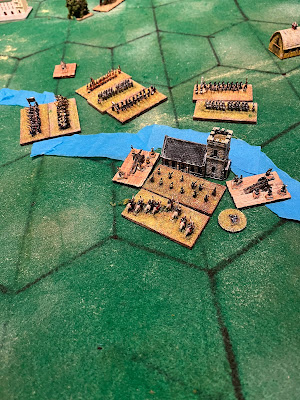Lieutenant Walter Carey of the 24th arrives bearing a despatch from Brigadier General Fraser giving a brief relation of an action his advance guard has had with the rebels at a place called Hubbardton.
"Please convey my respects to General Burgoyne and have him know that my brigade has driven off the rebel rearguard at Hubbardton. My forces have suffered some losses as a downpayment on this victory and we must remain in situ to reorganise and await replenishment. I regret to inform the General that His Majesty's Hessian auxiliaries arrived too late and they have been requested to follow up the rebel retreat."
So this evening I ran my second AWI remote game. This time against ex-pat wit and raconteur, the Jolly Broom Man. JBM took the Americans and I took the British. We ran the Live Free or Die scenario for Hubbardton, produced by the Wargames TV guys. The rules used were actually the vintage Loose Files and American Scramble as I'd used them before and as JBM hadn't yet used either we went with those. A couple of slight tweaks to the scenario were reducing the width from 5 to 4 feet (losing the action round the Sucker Brook) and to increase the number of bases in each unit as the space looked too big otherwise.
In a successful move to tempt me forward into a general action, JBM advanced his right hand unit (3rd rate, 2nd New Hampshire Regt). The Lights advanced forward (at rather a 'Hessian' rate) and drove back the New Hampshire boys.
Further along the line the Americans retired over the fence line to await the Brits. First to engage were the 24th foot with the 11 Massachusetts Regt. An ineffectual volley failed to bother the 24th who dashed forward and pushed the Americans back up the ridge. In more bad news for the Americans, Colonel Francis took a ball to the shoulder whilst cheering on the New Englanders, and had to retire from the field. The consequent loss of Command Points was to limit JBM's options from here on in. It was looking good for the Brits.
 |
| Top: the Lights have to halt a turn after driving off the New Hants Regt. Below that the 24th have advanced to the fence line and chased off the 11th Mass. |
 |
| 11th Mass from the British point of view. |
 |
| Same stage as photo 1, but from behind the British. |
After a brief pause the 24th advanced again, bayonets levelled menacingly. On the British right the combined grenadier battalion mannered towards the fence where they came up against Warner's Continentals and the rifles of the Green Mountain Boys.
 |
| The British have crossed the fence in the centre and prepare to 'go again'. |
 |
| The high watermark for the British. The beads are to represent Disorder Points, with the Americans now with a slight edge. |
Things then began to go wrong for the me and the British. The 11th Mass fought the 24th, first to a standstill, and then right back off the ridge and over the fence line. To their right the grenadiers were whittled down over a number of moves. The 24th lost 6 of 8 bases and the grenadiers 5 of 8. American losses totalled only 5 bases (2 for the New Hants regiment and 3 for the Mass.) More pertinently, JBM was able to retire these two regiments off the board whilst maintaining control of the Castleton Road. A Major Victory in the scenario.
 |
| An ominous sight for Fraser. The American line at the fence is in tact, whilst two regiments have already retired over the ridge. Game over and victory for JBM. |
So massive kudos and congratulations to JBM on the win, especially as it was his first outing with the rules. A big fat raspberry to me - losing is looking like a habit! Also, massive thanks for Mark for turning up, being a good sport and for regaling me with his (mis)adventures in deepest France. No names, no pack drill, but I'm sure he's now on a watch list with the Deuxième Bureau.
Friday will see a return of the scenario, this time with Jon F versus Steve W, with me as GM. what do the Brits need to do to win?







